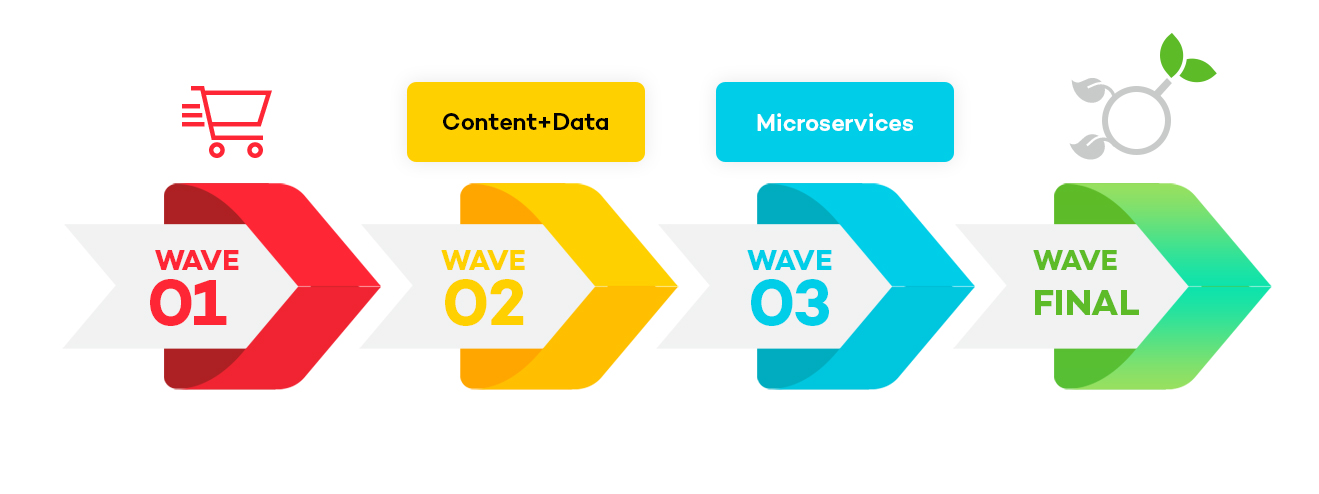A decade ago, having a digital presence might have sufficed for enterprise businesses. However, in today's dynamic and fiercely competitive environment, customer expectations for website experiences have significantly risen.
Retailers are well-acquainted with the challenges of overseeing a conventional, monolithic eCommerce platform. Constrained flexibility, scalability, and an absence of personalization can significantly hinder competitiveness in the contemporary digital marketplace.
Fortunately, a remedy for these challenges lies in adopting headless commerce.
What is Replatforming?
In simple terms, replatforming is selecting and changing the technology that powers your online store, commonly known as the eCommerce platform.
According to Statista Report, out of six in ten retailers will migrate to headless commerce platforms by 2024, and over 20% already use them.
Depending on your reasons for replatforming, you may encounter three primary types of eCommerce platform migration:
- Platform to platform (traditional approach)
This involves a complete transition from one eCommerce platform to another, aiming for enhanced integrations or functionalities. For example, moving from a Shopify SaaS solution to Adobe Commerce Cloud in a single transition. - Module by module (phased migration)
In this approach, the migration occurs incrementally, with different sections of your store moving in phases rather than all at once. For example, you might start by migrating your content management system while keeping the rest of your existing tech stack intact. - Monolithic to microservices
Opting for headless commerce development involves plugging in third-party systems based on your business requirements and customer journey. While it offers greater flexibility over the customer experience, it necessitates higher investments.
Why Replatforming?
It becomes important for your business to adapt to modern technology, which is changing rapidly. Your site may indeed have performed well a few years ago, but if you are not aware of the latest trends and tech that are happening around the industry, you are already out. Replatform conundrum is real! There may be some key reasons that you should know before replatforming. Some of these are:
- You are introducing a new product or entering a new business model that requires setting up multiple stores and multiple channels.
- You are expanding your existing business, which requires scaling up your website or app.
- You are entering into new regions and locations that require multiple-currency and international capabilities.
- You are integrating into all your channels to offer a seamless shopping experience to your customers.
In all these cases, you may be struggling with your current stack and want to replatform. Thus, before replatforming, you need to align your business goals with your current eCommerce store strategy.
Questions to Ask Yourself Before Re-Platforming to Headless
Here are some questions which you need to ask yourself before re-platforming to headless commerce.
Q1. What are your primary business goals, and how do headless commerce align with them?
Understanding your primary business goals is essential when considering the adoption of headless commerce. Whether you aim to enhance customer experiences, streamline operations, or expand your digital presence, aligning these objectives with the benefits of headless commerce is crucial.
According to the Report, almost 46% of retailers feel pressure to adopt commerce solutions and capabilities that might be inconsistent with their brand.
Headless architecture empowers businesses to achieve greater flexibility, scalability, and agility in adapting to evolving market demands. If your goal is to deliver a seamless and personalized customer experience across various touchpoints, headless commerce allows for tailored content delivery and dynamic user interfaces.
If your focus is on efficient content management and faster development cycles, the decoupled nature of headless architecture enables independent updates to the front end and back end, facilitating quicker iterations. Therefore, by clearly defining your primary business goals and recognizing how headless commerce aligns with them, you can make informed decisions that drive your business toward sustainable growth.
Q2. Is your current infrastructure compatible with headless commerce?
Assessing factors such as your existing content management system, databases, and third-party integrations is crucial. Compatibility hinges on the adaptability of your infrastructure to accommodate the flexibility and independence required by headless commerce.
If your current technology stack is scalable, and capable of seamless integrations, it may align well with the transition to headless commerce. On the other side, legacy systems that tightly integrate front-end and back-end functionalities may pose challenges.
According to Statista Report, eCommerce based on headless commerce can be integrated with third-party applications and sale channels including voice commerce, virtual reality.
A comprehensive evaluation of your infrastructure ensures a smoother and more successful integration of headless commerce, setting the stage for enhanced agility and innovation in your digital operations.
Q3. How will you manage content in a headless environment?
The challenge lies in determining how content creation, editing, and distribution will be handled. It is imperative to identify a robust content management system that aligns with your business needs and integrates seamlessly with the headless structure.
Striking the right balance between content creation and delivery mechanisms is key to maximizing the advantages of a headless environment, ultimately providing your users a seamless and engaging experience.
Q4. Does your team have enough expertise with headless architecture, or requires additional training?
Assessing your team's expertise with headless architecture is paramount when considering its adoption. A shift to a headless approach demands a certain level of proficiency in handling decoupled front-end and back-end systems.
Evaluate whether your existing development team possesses the requisite skills and familiarity with headless commerce
principles. If the expertise is lacking, investing in additional training becomes essential. This training could encompass understanding the intricacies of API-driven communication, implementing microservices, and effectively managing a modular structure.
Bridging this knowledge gap ensures that your team is equipped to navigate the complexities of headless architecture, enabling them to harness its benefits fully.
Whether through upskilling your current workforce or hiring individuals experienced in headless development, ensuring your team has the required expertise is crucial for the seamless implementation and ongoing success of a headless commerce strategy.
Q5. Does your current CMS platform support multiple languages and different languages?
When considering the transition to a headless CMS through replatforming, one crucial aspect to evaluate is the system's support for multiple languages. In today's globalized digital era, catering to diverse audiences demands seamless multilingual capabilities. Assess whether your current CMS platform can efficiently manage and present content in different languages.
According to the Webinarcare Report, 90% of retailers face challenges translating their content into various languages, while only 30% integrate their CMS with various languages or translation management systems.
A robust headless CMS should empower content creators to easily create, manage, and deliver content in various languages, ensuring a consistent and engaging user experience for audiences around the world. This capability not only enhances your website's accessibility but also plays a pivotal role in expanding your reach and connecting with a broader and more diverse user base.








.png?h=250&fm=webp)
.png?h=250&fm=webp)
.png?h=250&fm=webp)



.png?h=250&fm=webp)
.png?h=250&fm=webp)
.png?h=250&fm=webp)


.png?h=250&fm=webp)



.png?h=250&fm=webp)
















.png?h=250&fm=webp)

.png?h=250&fm=webp)
.png?h=250&fm=webp)



































































































































.png?h=250&fm=webp)


.jpg?h=250&fm=webp)





 copy.png?h=250&fm=webp)























_ Why do you need one.png?h=250&fm=webp)


























































.jpg?h=250&fm=webp)

.png?h=250&fm=webp)



.png?h=250&fm=webp)

.jpg?h=250&fm=webp)




.png?h=250&fm=webp)









.jpg?h=250&fm=webp)
